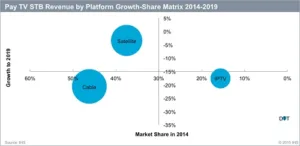The pay-TV set-top box (STB) market shrank for the first time in over a decade last year, says IHS. From $15.9 billion in 2013, the market fell to $15.3 billion. It is the first contraction since 2002.
Shipments were up slightly, to 204.7 million units – an increase of just under 1% from 2013’s 203.1 million units. However, such a modest amount of growth failed to compensate for price erosion.
Pay-TV STB vendors have benefited from many factors in the last 12 years. These include strong global pay-TV growth; cable digitisation mandates; PVR introduction; HDTV; and IPTV rollouts. All of these helped to sustain market growth. However, the industry is now at an inflection point. “Mature pay TV markets are saturated with high-value advanced boxes, so shipments are set to decline there; and operators in emerging markets aren’t transitioning to advanced boxes fast enough to increase overall industry value”, said IHS’s Daniel Simmons.
The first half of 2015 has already shown signs of STB consolidation, foreshadowing a declining market. For example, Woojeon & Handan, of South Korea, left the market; Switzerland’s ADB delisted from the SIX Swiss Exchange; TiVo and Amino, in the USA and UK, respectively, have acquired pay-TV software companies; and market leader Arris announced its intention to acquire Pace, the market’s second-largest company by revenue.
IHS expects the pay-TV STB market to fall to $15.1 billion this year, and $13.2 billion in 2018. 2019 will see stabilisation. Almost all segments will experience a fall in value, but the satellite pay-TV STB market will sustain the most value, and provide the highest opportunity for vendors.
Most satellite operators are not ISPs, unlike cable and IPTV companies. This means that it is harder for them to virtualise traditional STB functionality, such as DVR, into the cloud. These operators will need to invest in STB hardware, to enable services that can compete with cable and IPTV operators.
Continued pay-TV growth in emerging regions – such as MEA and South and Central America – will provide STB growth opportunities over the forecast period.
Commenting on Arris’s acquisition of Pace, bearing the above in mind, Simmons says that the move makes sound sense. It is highly likely that there will also be further consolidation, as other vendors seek to secure growth through acquisition and compete with Arris’s new scale. “Vendors that are strong in satellite STBs and emerging markets, such as Altech Multimedia, Humax, Sagemcom and Technicolor, could be key acquisition targets”, he said.
The introduction of UltraHD could provide some longer-term STB growth opportunity. New boxes will be required to decode this content. Future launches in Asia and North America will result in $240 million worth of UltraHD STBs shipped to pay-TV service providers this year. IHS estimates that shipments will be worth $5.4 billion by 2019, with a 40% revenue share.

